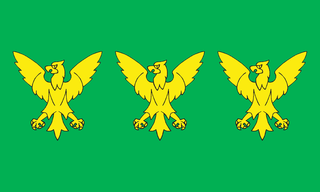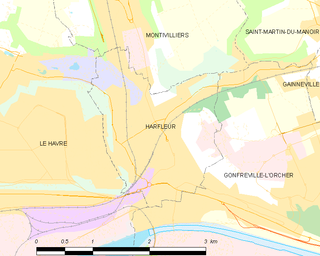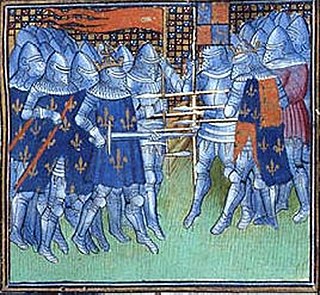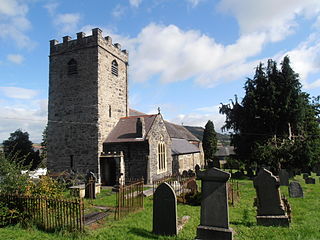
The Battle of Agincourt was an English victory in the Hundred Years' War. It took place on 25 October 1415 near Azincourt, in northern France. The unexpected English victory against the numerically superior French army boosted English morale and prestige, crippled France and started a new period of English dominance in the war.

The English longbow was a powerful medieval type of longbow about 6 ft (1.8 m) long used by the English and Welsh for hunting and as a weapon in warfare. English use of longbows was effective against the French during the Hundred Years' War, particularly at the start of the war in the battles of Sluys (1340), Crécy (1346), and Poitiers (1356), and perhaps most famously at the Battle of Agincourt (1415). However they were less successful after this, with longbowmen having their lines broken at the Battle of Verneuil (1424) though the English won a decisive victory, and being completely routed at the Battle of Patay (1429) when they were charged by the French mounted men-at-arms before they had prepared the terrain and finished defensive arrangements. The Battle of Pontvallain (1370) had also previously shown longbowmen were not particularly effective when not given the time to set up defensive positions.

Owain ap Gruffydd, lord of Glyndyfrdwy, or simply Owain Glyndŵr or Glyn Dŵr, was a Welsh leader who instigated a fierce and long-running yet ultimately unsuccessful war of independence with the aim of ending English rule in Wales during the Late Middle Ages. He was the last native Welshman to hold the title Prince of Wales.

Year 1415 (MCDXV) was a common year starting on Tuesday of the Julian calendar.

Henry V, also called Henry of Monmouth, was King of England from 1413 until his death in 1422. Despite his relatively short reign, Henry's outstanding military successes in the Hundred Years' War against France made England one of the strongest military powers in Europe. Immortalised in Shakespeare's "Henriad" plays, Henry is known and celebrated as one of the greatest warrior kings of medieval England.

Henry V is a 1944 British Technicolor film adaptation of William Shakespeare's play of the same name. The on-screen title is The Chronicle History of King Henry the Fifth with His Battell Fought at Agincourt in France. It stars Laurence Olivier, who also directed. The play was adapted for the screen by Olivier, Dallas Bower, and Alan Dent. The score is by William Walton.

Caernarfonshire, historically spelled as Caernarvonshire or Carnarvonshire in English, is one of the thirteen historic counties, a vice-county and a former administrative county of Wales.

The Siege of Harfleur was conducted by the English army of King Henry V in Normandy, France, during the Hundred Years' War. The defenders of Harfleur surrendered to the English on terms and were treated as prisoners of war. The English army was considerably reduced by casualties and an outbreak of dysentery during the siege but marched towards Calais, less a garrison left behind at the port. The English were intercepted en route and fought the Battle of Agincourt, inflicting a huge defeat on the French.

Sir Thomas Erpingham was an English soldier and administrator who loyally served three generations of the House of Lancaster including English kings Henry IV and Henry V, and whose military career spanned four decades. After the Lancastrian usurpation of the English throne in 1399, his career in their service was transformed as he rose to national prominence, and through his access to royal patronage he acquired great wealth and influence.

John Jones Maesygarnedd was a Welsh military leader and politician, known as one of the regicides of King Charles I following the English Civil War. A brother-in-law of Oliver Cromwell, Jones was a Parliamentarian and an avid republican at a time when most of Wales was Royalist, and became one of 57 commissioners that signed the death warrant authorising the execution of Charles I following his trial. After the Restoration of the monarchy, Jones was one of few excluded from the general amnesty in the Indemnity and Oblivion Act, and was tried, found guilty, then hanged, drawn and quartered at Charing Cross.

Dafydd ap Llewelyn ap Hywel, better known as Dafydd Gam, anglicized to David or Davy Gam, was a Welsh warrior, a prominent opponent of Owain Glyndŵr. He died at the Battle of Agincourt fighting for Henry V, King of England in that victory against the French.

The Oriflamme was the battle standard of the King of France in the Middle Ages. It was originally the sacred banner of the Abbey of St. Denis, a monastery near Paris. When the oriflamme was raised in battle by the French royalty during the Middle Ages, most notably during the Hundred Years War, no prisoners were to be taken until it was lowered. Through this tactic they hoped to strike fear into the hearts of the enemy, especially the nobles, who could usually expect to be taken alive for ransom during such military encounters.

Saint Mael and Saint Sulien's Church is a church located in the town of Corwen in Denbighshire in Wales. It was formerly in the ancient county of Merionethshire.
The Battle of Bryn Glas, was fought on 22 June 1402, near the towns of Knighton and Presteigne in Powys. It was a great victory for the Welsh under Owain Glyndŵr, and it resulted in the prolongation of the Welsh war of independence and the destabilisation of English politics for several years afterward.

The Flag of Berkshire is the flag of the historic county of Berkshire in England. The flag was registered with the Flag Institute as the flag of the county in March 2017. The flag was adopted after the design was submitted by a number of county-based bodies as well as the Lord Lieutenant of the county. Prior to adoption, a banner of the arms of the former Berkshire County Council had been occasionally used to represent the county.

The Glyndŵr Rising, Welsh Revolt or Last War of Independence was an uprising of the Welsh between 1400 and 1415, led by Owain Glyndŵr, against the Kingdom of England. It was the last major manifestation of a Welsh independence movement before the incorporation of Wales into England by the Laws in Wales Acts 1535–1542.
Anne Elizabeth Curry is an English historian.
Benedict Nichols, also spelt Nicholls was a priest and bishop of the Roman Catholic Church, successively a parish priest in England, a canon of Salisbury Cathedral, and Bishop of Bangor and Bishop of St David's in Wales.

The King is a 2019 epic war film directed by David Michôd, based on several plays from William Shakespeare's "Henriad". The screenplay was written by Michôd and Joel Edgerton, who both produced the film with Brad Pitt, Dede Gardner, Jeremy Kleiner, and Liz Watts.

Owen Glendower is a character in William Shakespeare's play Henry IV, Part One based on the historical Owain Glyndŵr. Glendower is referred to in Henry IV, Part Two, but he does not have a speaking role in that play.

















